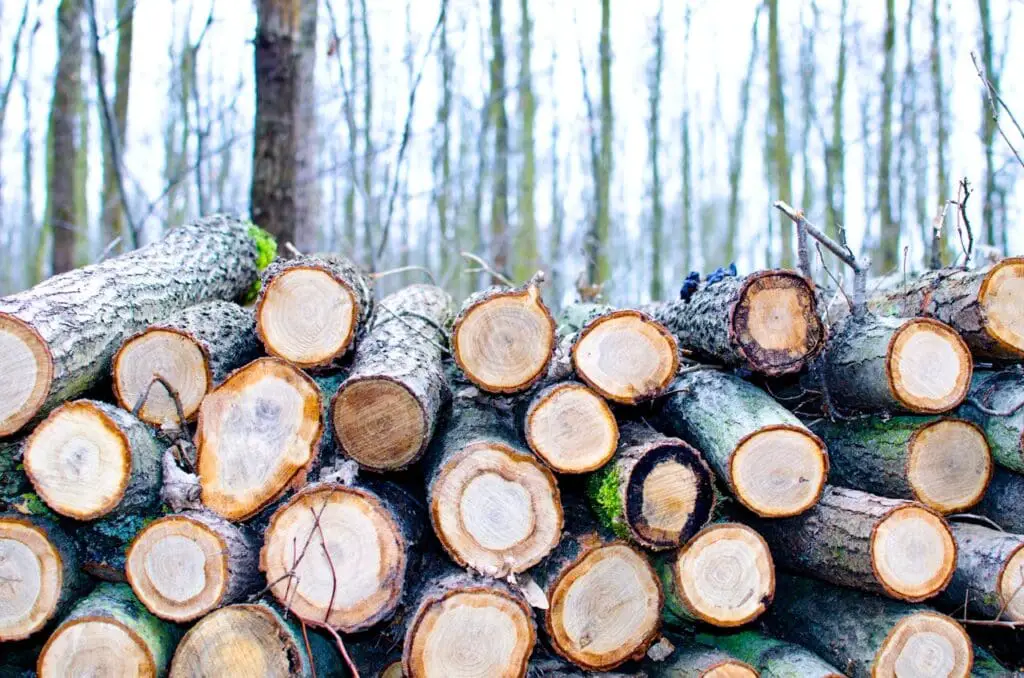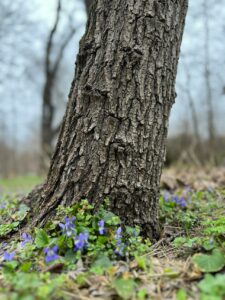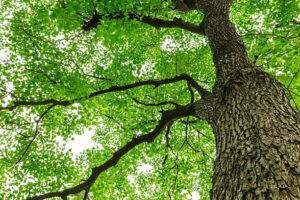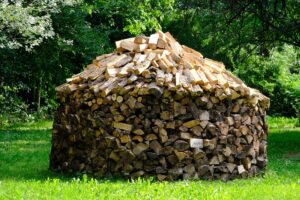The primary market for timber products is construction. This includes new single-family residential construction and repairs, nonresidential repair and remodeling, and construction panels.
Dimension lumber is graded based on overall strength rigidity and appearance, such as the number of knots or defects in the wood. Logs that don’t cut dimension lumber can be processed into a range of timber by-products.
Common By-Products
Timber processing creates environmental impacts in several ways. These are categorized as physical impacts, energy use, and generation of GHG emissions. Increasing global demand for timber products can lead to the deterioration of the world’s forest resources, which also creates the challenge of fulfilling this demand without compromising the environment. It is therefore imperative to understand the full life cycle of timber products to maximize resource utilization and reduce waste.
During the lumber process of the production of solid wood forest products, by-products are generated in the form of residue from log debarking, sawing into boards, and kiln drying. These by-products are used for a variety of applications including landscaping, pet bedding, and hog fuel for co-generation of electricity. Additionally, the bark is often distilled to extract tannins and other chemicals such as resins and flavorings. By-products also generate significant amounts of sawdust which is commonly marketed as wood shavings, mulch, and wood fuel.
The value of timber increases through various stages in the processing chain, from the harvest and the stumpage value paid to landowners for their trees, through delivery and sale values of finished goods. The main factors influencing timber value are forest growth and species composition, as well as past and present management activities.
A large proportion of the environmental impact associated with timber processing is related to the transportation of timber and its by-products. This transportation is done either by road or rail and uses fossil fuels, which causes GHG emissions. It is estimated that the forest sector contributes up to 17% of global GHG emissions.
In addition to those created by the transportation of timber and its by-products, the manufacturing process itself also produces GHG emissions. However, these emissions can be reduced by using bioenergy sources instead of fossil fuels. Furthermore, timber products can work towards decreasing global warming trends by acting as carbon sinks – it takes decades for new trees to re-absorb the carbon released when their predecessors are burned. To minimize the environmental impact of timber processing and manufacturing, it is important to incorporate environmental sustainability into the design and operation of sawmills and wood product companies.
Specialty By-Products
The timber industry contributes to global GHG emissions in several ways from harvesting through manufacturing processes and end-use/disposal. Manufacturing-related emission is the dominant contributor and accounts for 55% of total emissions. In addition to the direct GHG emissions, the timber production process generates waste such as bark, slabs, sawdust, wood chips, coarse residues, planer shavings, peeler log cores, and end trimmings. Appropriate wood waste utilization significantly reduces these emissions and environmental impacts without damaging the world’s forest resources.
The specialty products market has grown rapidly in recent years. This is mainly due to economic growth and increased consumer affluence, health and wellness awareness, internationalization of markets, regulatory changes and standards, and cultural and lifestyle shifts. In addition, the furniture market is growing fast because of the increasing demand for specialty products such as hardwood veneers, plywood, and engineered composites.
Specialty products are characterized by their uniqueness, quality features, and brand recognition. They are often produced in small quantities, have a higher cost, and are marketed to a sizeable customer base.
As a result, they are a key part of the overall value chain. They are an important source of revenue for the forest industry and their marketing can play an essential role in the success of a company. Consequently, companies must invest in their marketing and product development to ensure the quality of the specialty products they produce.
Generally, the highest-value products in the market for solid timber forest products are the end-uses for construction. This includes renovations, conversions, and extensions, which make up about 37 percent of the total consumption of timber products in Sweden. The products are primarily supplied by the product themselves to DIY and professional customers through builders’ merchants.
The market for specialty timber products is highly competitive. The price of specialty timber products can vary considerably depending on the quality, production processes, marketing, and other factors. For example, the stumpage value of a harvested tree is determined by several different factors including timber quality and quantity, logging costs, transportation expenses, and local market conditions. As a result, landowners need to understand these differences in stumpage values to make the most of their timber sales and maximize financial return from their forest.
Applications
Timber is not only a valuable raw material in its own right but also serves as an essential input in a wide range of other industries like wood pulp and paper, bioenergy, and landscaping. Pulpwood from timber is used to create a wide variety of paper products including book covers, printing materials, and envelopes. Other paper products made from pulpwood include kraft, parchment, and packaging paper.
Wood from lower-quality timber is also used for the creation of wooden boxes and crates for shipping and storage. Timber also finds use as an energy source when burned to produce biomass fuel. For example, timber can be converted into charcoal through a process called carbonization. The result is a product that is both clean and renewable, which can then be used to generate electricity or heat homes.
The forestry industry is increasingly turning to alternative building materials like mass timber, which can build structures that are far taller than traditional light frame construction methods. This innovation is possible because of the availability of engineered wood products, or EWPs. These wood-based structural panels include plywood, oriented strand board (OSB), and cross-laminated timber. These panels can be structural or non-structural and can replace dimension lumber elements in construction applications.
These EWPs are produced using larger log sections that can be cut straight from the trunk of a tree and then glued together. These panels have more consistent physical properties than sawn lumber and are typically better dimensionally stable and stronger. This allows them to replace structural steel and concrete in a broad range of building applications.
In addition to the industrial uses for timber, the natural beauty of this product makes it an attractive option for landscaping. For instance, cedar is often used to make fencing and patio covers. This material is a popular choice because it is resistant to insect attacks and is durable and long-lasting.
Other types of timber are used to make flutes, musical instruments, window blinds, and fishing rods. It is also a great choice for interior finishes like molding and paneling. However, some of these timbers have specific characteristics that limit their uses. For example, cherry timber has gum pockets and pith flecks, which can cause tear-out during machine operations. It can also be a respiratory irritant.
Innovative Approaches
By fostering an innovative culture, you can build connections with customers that strengthen loyalty. This can include offering higher value re-added services beyond timber harvesting, such as forestry consulting or arranging forest management workshops. This personalized approach builds a connection with your clients and helps you stand out from competitors.
By developing and implementing innovative technologies, you can maximize the value of pine trees and minimize waste of your timber by-products. This includes utilizing cutting-edge technology to improve supply chain efficiency, such as GPS tracking systems and digital communication tools. Using these advanced tools can help streamline transportation and logistics by optimizing routes, enabling real-time monitoring of driver schedules, minimizing delays caused by unforeseen circumstances, and maximizing overall delivery efficiency.
Increasing the production of value-added timber products can boost your sales and profitability. Using sustainable forestry practices also contributes to the health and biodiversity of forests and ecosystems, reducing vulnerability to pests and disease. This translates into higher-quality timber, which can increase market demand and command a premium price.
Another way to optimize your operations is by collaborating with companies that specialize in transporting timber. These companies can streamline the timber sale process by managing transportation and logistics, enabling you to focus on your core business. Moreover, partnering with these companies can help you minimize costs and ensure timely deliveries.
The environmental impacts of the entire timber production process from sawmills to final wood products can be assessed through Life Cycle Assessment (LCA) methods. LCA examines the energy and material resources used, manufacturing and processing steps, emissions, and disposal of byproducts, as well as their impact on the site and corresponding environment. By improving energy consumption, minimizing product waste, and using environmentally friendly energy sources, you can reduce your timber’s environmental footprint and mitigate the negative impacts on the environment.
By integrating the cradle-to-grave principle into your timber products, you can promote a circular economy within the forestry sector. This means using recycled timber and byproducts for new timber products or energy, thereby prolonging their service life and reducing waste. Reusing by-products for timber and other products can also minimize landfill waste by avoiding degradable organic carbon dissemination into methane, which has 25 times more global warming potential than carbon dioxide.






